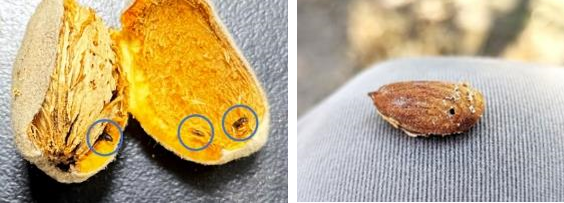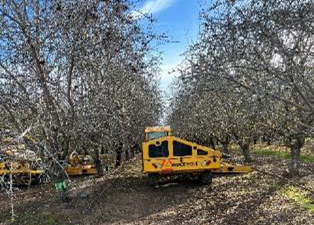Sudan Gyawaly, Area IPM Advisor, Butte, Colusa, Yuba-Sutter, Glenn, and Tehama Counties
The California nut industry experienced alarmingly high navel orangeworm (NOW) damage this past year. Sacramento Valley growers were not an exception, and many growers in our area experienced levels of damage not seen since the early 1980s. Statewide, insect (NOW) damage in processor reports is expected to be at least 4% with actual damage at least 8% of the total crop. On average, NOW cost California growers hundreds of dollars per acre.
NOW is probably the most challenging pest to control in almond production. Various biological (ability to reproduce large numbers of offspring per generation over multiple generations per season, for example) and behavioral (ability to reproduce and survive on multiple and poor-quality hosts, ability to fly among crops/orchards) characteristics of this pest and its relationship to crop phenology (i.e., hullsplit) make it difficult to predict its risks and the effectiveness of management practices in a particular year. For pests like NOW, which can cause substantial damage if unchecked, minimizing the risk of damage requires using multiple management tactics. These practices are winter sanitation, mating disruption, well-timed insecticide sprays, and timely harvest.
Winter sanitation is the practice of removing and destroying unharvested (“mummy”) nuts and is widely recognized as the foundation of NOW management. Mummy nuts support NOW by providing a shelter for overwintering larvae and serve as the only habitat for egg laying and survival of the first generation NOW in an orchard. With high pest pressure in the fall of last year, mummies likely had a higher NOW infestation rate than in “normal” years. Performing winter sanitation properly helps check NOW population build-up, and thus the damage, both by directly killing NOW worms that shelter in the mummy nuts during winter and by depriving NOW adults and larvae of the shelter and food during spring.
Determining winter sanitation needs and sanitation methods.
To determine the need for sanitization, count the number of mummy nuts in 20 trees, including all varieties, in each block once leaves are off the trees. In the Sacramento Valley, UC IPM recommends sanitizing to fewer than two nuts/tree on average (fewer than 40 nuts total on the 20 trees). However, in the southern San Joaquin Valley, where NOW pressure is usually higher than in the Sacramento Valley, UC IPM recommends sanitizing mummies to 1 per 5 trees (0.2 nuts/tree, or 4 nuts total on the 20 trees) and eight or fewer mummies on the ground in order to reduce NOW damage in the next crop. Given that NOW damage in our region this year was comparable to the southern San Joaquin Valley, practicing more stringent sanitization is essential, especially if you encountered a high level of NOW damage this year. Remove mummy nuts from trees by shaking trees (and/or hand polling if necessary) to remove nuts before bud swell. In a recent study shaking was done into early February without reducing yield. Finally, blow or sweep fallen nuts into orchard middles and flail mow by mid-March. Confirm successful sanitation by counting remaining mummies in trees and on the ground after shaking and mowing.
Winter sanitation can help reduce the risk of other pests.
Recently, an invasive insect pest known as carpophilus beetle has been detected attacking almonds and pistachios in multiple San Joaquin Valley counties (Stanislaus, Merced, Madera, and Kings). This beetle can also attack walnuts, based on reports from other countries, including Italy, Chile, and recently Australia.
Carpophilus beetle (Scientific name, Carpophilus truncatus) is a tiny insect (~ 1/10th of an inch long) that has become a key pest of almonds in Australia since 2013. The carpophilus beetle attacks nut crops by infesting nut kernels. Infested kernels, especially almonds, can sometimes have ‘oval tunnel’ and ‘fine powdery frass’ on the nutmeat that may indicate carpophilus beetle infestation. The fine powdery frass on the surface of the kernel also resembles pin hole damage caused by first instar NOW larvae. Oval tunnels, powdery frass, and lack of webbings in the kernel are strong indicators of beetle infestations.

Adult carpophilus beetles (left) and oval hole on almond kernel made by beetle feeding (right), Photos: Jhalendra Rijal (left) and Houston Wilson (right)
There are a lot of unknowns about this pest, such as its damage potential and monitoring and management methods in California. However, available information indicates this beetle relies on nuts on the ground and in trees for their survival, so the removal and destruction of mummies is the only effective way to minimize the chances of establishment and damage by this pest.



Leave a Reply